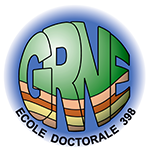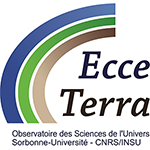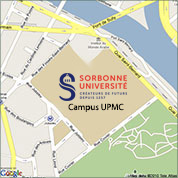Séminaire ISTeP - Kevin Mahan
(U. Boulder)
Seismic anisotropy in localized shear zones versus distributed tectonic fabrics: examples from geologic and seismic observations in western North America and the European Alps
Modern methods for detecting seismic anisotropy offer an array of promising tools for imaging deep crustal deformation but also present challenges, especially with respect to potential biases in both the detection methods themselves as well as in competing processes for localized versus distributed deformation. We address some of these issues from the geophysical perspective by employing azimuthally dependent amplitude and polarity variations in teleseismic receiver functions combined with a compilation of published rock elasticity tensors from middle and deep crustal rocks, and from the geological perspective through studies of shear zone deformation processes. Examples are highlighted at regional and outcrop scales from western North America and the European Alps.
First, in regional patterns, strikes of seismically detected fabric from receiver functions in California show a strong alignment with current strike-slip motion between the Pacific and North American plates, with high signal strength near faults and from depths below the brittle-ductile transition suggesting these faults have deep ductile roots. In contrast, despite NE-striking shear zones being the most prominent features portrayed on Proterozoic tectonic maps of the southwestern USA, receiver function anisotropy from the central Rocky Mountain region appears to more prominently reflect broadly distributed Proterozoic fabric domains that preceded late-stage localized shear zones. Possible causes for the discrepancy fall into two categories: those that involve a) bias in seismic sampling and/or b) deformation processes that lead to either weaker anisotropy in the shear zones compared to adjacent domains or to a symmetry that is different from that conventionally assumed. Most of these explanations imply that the seismically sampled domains contain important structural information that is distinct from the shear zones.
The second set of examples stem from studies of outcrop-scale shear zones in upper amphibolite-facies (0.9-1.0 GPa, 700 °C) mafic metagabbro from Precambrian exposures in Montana (USA) and in greenschist-facies (0.7-0.8 GPa, 450-500 °C) metagranites from the External Crystalline Massifs of the European Central Alps. The shear zones are characterized by strain gradients from undeformed coarse-grained protoliths to very fine grained ultramylonite, and by microstructures dominated by CPO-producing deformation mechanisms in the protomylonite and CPO-weakening mechanisms such as dissolution-precipitation creep and grain boundary sliding in the ultramylonite. In the mafic mylonites, the result is a lower seismic anisotropy (~2%) in the core of the shear zones despite a well-developed hornblende shape-preferred orientation. Preliminary observations of these examples suggest that marginal gradients may contribute as much or more to the bulk anisotropy signal compared to the higher strained cores of these structures. If true, a similar effect could explain some otherwise puzzling anisotropy studies of larger scale shear zones such as from the Himalaya where anisotropy tilt proximal to the Main Himalayan Thrust is notably steeper than expected.
In conclusion, while some anisotropy studies of crustal scale deformation patterns are relatively straightforward, others will require careful consideration of the limitations and potential future improvements to seismic detection methods, including ground truthing with samples and exposures, as well as a better understanding of the physical and chemical processes involved in deformation localization.
24/02/2017, Salle Fourcade à 12h30
Egalement dans la rubrique
- Séminaire ISTeP - Tatsuhiko Kawamoto
- Séminaire ISTeP - Boris Chauviré
- Séminaire ISTeP - Jacques Bourgois
- Séminaire ISTeP - Michael Hermoso
- Séminaire ISTeP - Alexis Nutz
- Séminaire ISTeP - Marta Gasparrini
- Séminaire ISTeP - Chloé Loury
- Séimnaire ISTeP - Silvio Ferrero
- Séminaire ISTeP - Simon Andrieu
- Séminaire ISTeP - Johan Le Goff
- Séminaire ISTeP - Benjamin Bruneau
- Séminaire ISTeP - Amandine Prelat
- Séminaire ISTeP - Damien Do Couto
- Séminaire ISTeP - Silvia Omodeo Salé
- Séminaire ISTeP - Céline Ducassou
- Séminaire ISTeP - Jean Nizou
- Séminaire ISTeP - Charlotte Ribes
- Séminaire ISTeP - Yohann Poprawski
- Séminaire ISTeP - Yael Sagy
- Séminaire ISTeP - Diane Bonnemains
- Séminaire ISTeP - Muriel Laubier
Chiffres clés (Mars 2025)
L'ISTeP comprend 131 membres dont :
Permanents (66)
- Professeurs : 17 (+2 PAST)
- Maîtres de conférence : 26
- Directeurs de recherche CNRS : 1
- Chargés de recherche CNRS : 1
- ITA : 19
Personnels non permanents (65)
- Collaborateurs bénévoles / émérites : 17
- Chaire de professeur junior : 1
- Enseignants-chercheurs contractuel : 2
- 1 MCF accueil en délégation
- ATER et Post-Docs : 9
- Doctorants : 32
- ITA-BIATSS : 3





